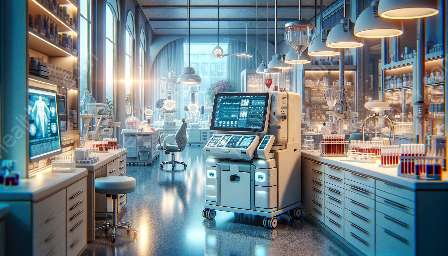Anesthesia machines are critical tools used in the administration of anesthesia during medical procedures. These advanced devices play a crucial role in the safe and efficient delivery of anesthetic agents to patients. This topic cluster will delve into the detailed exploration of anesthesia machines, including their components, functions, and maintenance, within the context of clinical testing equipment and medical devices & equipment.
Anatomy of Anesthesia Machines:
An anesthesia machine consists of essential components that work together to deliver and monitor the administration of anesthesia. These components include the gas supply system, vaporizers, breathing circuit, and ventilator. Each part plays a vital role in ensuring the accurate delivery and control of anesthetic agents to the patient.
Gas Supply System:
The gas supply system of an anesthesia machine is responsible for providing the necessary gases used in anesthesia administration. These gases commonly include oxygen, nitrous oxide, and air. The system ensures the proper mixing and delivery of these gases to achieve the desired concentration for anesthesia induction and maintenance.
Vaporizers:
Vaporizers are key components in anesthesia machines that enable the precise delivery of volatile anesthetic agents. These devices are designed to control the concentration of anesthetic vapor delivered to the patient, ensuring accurate dosing and minimizing the risk of overdose or underdose.
Breathing Circuit:
The breathing circuit connects the anesthesia machine to the patient's airway, facilitating the delivery of the anesthetic agent. It comprises tubing, connectors, and a patient interface (such as a face mask or endotracheal tube) to maintain a safe and controlled exchange of gases during anesthesia administration.
Ventilator:
Anesthesia machines are equipped with ventilators that assist in providing mechanical ventilation to the patient during anesthesia. These ventilators ensure adequate respiratory support, delivering oxygen and removing carbon dioxide to maintain appropriate gas exchange and support the patient's breathing throughout the procedure.
Functions and Control Mechanisms:
Modern anesthesia machines are equipped with advanced functions and control mechanisms to enhance the safety and precision of anesthesia administration. These include gas concentration monitoring, pressure and volume control, as well as alarms and safety features to alert healthcare providers of potential issues during the procedure.
Maintenance and Quality Assurance:
Proper maintenance and regular clinical testing of anesthesia machines are essential to ensure their reliability and safety. Routine inspections, calibration of gas delivery systems, and functional testing of the machine's components are crucial for identifying and addressing any potential issues that could compromise patient safety.
Interplay with Clinical Testing Equipment:
Anesthesia machines are closely related to clinical testing equipment, as both play integral roles in ensuring the safety and effectiveness of medical procedures. Clinical testing equipment, such as gas analyzers, flow meters, and pressure gauges, are used to assess and validate the performance of anesthesia machines, ensuring their accuracy in delivering anesthetic agents and maintaining patient safety.
Regular calibration and validation of clinical testing equipment are essential to verify the accuracy of gas concentrations, flow rates, and pressure settings, thereby safeguarding the proper functioning of anesthesia machines and enabling healthcare providers to deliver anesthesia with confidence.
Integration with Medical Devices & Equipment:
Anesthesia machines are part of a broader ecosystem of medical devices and equipment utilized in operating rooms and critical care settings. These devices include patient monitors, infusion pumps, and airway management tools, all of which work in synergy with anesthesia machines to ensure comprehensive patient care and safety.
Seamless integration of medical devices and equipment is crucial for maintaining a well-coordinated and efficient anesthesia delivery system. Interoperability between these systems enables healthcare providers to monitor vital signs, administer medications, and manage airway access while maintaining the appropriate anesthetic state for the patient.
Understanding the intricate connections between anesthesia machines and medical devices & equipment is pivotal in creating a cohesive environment that prioritizes patient well-being and procedural success.


